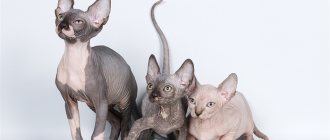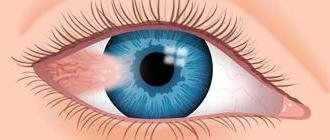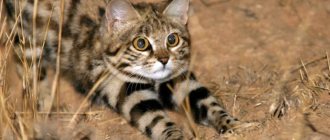Have you ever held such an animal as the Don Sphynx at least once in your life? Anyone who has seen it at least once will confirm that it is magnificent. Very warm to the touch and gentle, the Sphynx cat will immediately fall in love with you! Today, the popularity of this Russian breed has increased; it is loved not only here, but also abroad. But at the same time, I would like to say that loving the Don Sphynx is not enough; you also need to know how to care for it, what diseases it may develop and how to treat them. Therefore, in this article we will tell you how to keep your pet healthy.
Brief description of the breed
An elegant and unusual animal appeared in 1986 due to a mutation; this cat was first seen in Rostov-on-Don. Today, this breed is wildly popular in many countries around the world. And this is not surprising, because the Don Sphynx is a very unusual creature from which one cannot remain indifferent.
The animal is very affectionate and devoted to its owner; allergies are less likely to occur from it than from other breeds of cats, since it has no hair. The completely hairless breed is distinguished by its velvety coat. Such a cat has every chance of becoming a show winner. I would like to note that the Sphynx board is distinguished by good health, so if you properly care for it, diseases may not appear at all. The most important thing in caring for this animal is that it does not become hypothermic. Pay more attention to hygiene and then health problems will not arise.
General health information
Sphinxes are by no means distinguished by poor health. Their immunity is consistent with other cat breeds. They are also susceptible to viral and bacterial infections. The differences relate to wool - due to its absence, the skin sweats more, like in humans, and dermatitis may appear. Sphynx cats do not have eyelashes, which leads to blepharitis and conjunctivitis. Due to inbreeding, the risk of congenital anomalies is high.
Diseases of a hygienic nature
- Microphthalmos. This is a congenital defect of the eyeball; it is reduced in size. As a rule, this pathology occurs due to an infection suffered during pregnancy. The pathology, as a rule, leads to decreased vision and is treated exclusively with surgery.
- Curvature of the tail. With this disease, pathology of the skeletal system is observed. As a rule, this is a congenital defect; very often kittens with such a congenital defect have underdeveloped intestines and a dwarf appearance. The reason for this anomaly is inbreeding.
Sphynx allergies
If you want to get normal kittens, you need to carefully study the entire pedigree of the family so that they do not have a similar disease in their family.
- Nipple hyperplasia. Typically, small kittens inherit this disease from their mother. Sometimes the cause of this pathology may be the improper use of medications. The nipples of such animals increase in volume, swell and become very painful. A cyst may form, females often give birth to poor offspring, this is due to concomitant diseases. Since the mother is unable to breastfeed the kittens, they have virtually no chance of survival.
Diagnostics
Experts always ask:
- Cat's diet.
- Date of first symptoms.
- Pet hygiene products.
- Cleaning products in the house.
- Is the animal taking medication?
Sphynxes are very sensitive to everything, you need to tell the veterinarian every detail, because the animal may be allergic to your perfumes or plants.
How does pregnancy and childbirth proceed?
Sphynx cats tolerate pregnancy well and give birth on their own; their instinct is excellent, which is very valuable. Kittens are born full term, grow well and develop well. Naturally, for the pregnancy to be successful, it is necessary to take care of the cat from the first days, then the birth will take place without complications.
Here are some tips for preparing for childbirth
- In order for your cat to give birth to healthy kittens, you need to give birth in comfortable conditions. Therefore, as soon as the cat becomes pregnant, you need to take care of her birth place. You can prepare a cardboard box and cover it with a sheet to make it more comfortable for the kittens to be there.
- If the birth is already close, you need to prepare the necessary things that will be useful to you, this is a heating pad, it will need to be filled with warm water, a second diaper, sterile scissors. Even if your cat's pregnancy went smoothly, delivery can still be complicated, so you need to be prepared for anything.
- If you notice that your cat has begun to eat poorly and hide in inaccessible places, you should know that your cat is already in the last stage of pregnancy. Perhaps this behavior indicates the cat is having contractions. Therefore, if you notice that the animal is not behaving as usual, it is better to play it safe and try to move it into a box. But this must be done carefully and carefully so that the animal does not get scared, otherwise she will not give birth there.
How to accustom a Sphynx kitten to a scratching post and stop it from scratching furniture?
You can't force a cat to do anything it doesn't want to do. also very difficult to get her to stop doing what she likes . Therefore, when training to use a scratching post, it is necessary to redirect the kitten’s/cat’s desires in the right direction. Cats do not understand physical punishment, so hitting them is useless. Hitting will only worsen your relationship, and the cat will begin to avoid you. Cats have excellent memories and sometimes hold grudges for a long time.
Before you start training a scratching post, you should know that cats try their claws on anything and everything for several reasons: - marking territory (scratching is an innate territorial instinct), - exercise (scratching serves to keep the cat in physical shape), - for pure pleasure, - changing the dead top layer of the sheath growing on top of the claw (thanks to this, cats' claws are always sharp).
Now you need to choose the right scratching post. Its height should be such that the cat can fully extend its body with its paws (not shorter than 70 cm). Pillar scratching posts are considered the best. When choosing, pay attention to the stability and safety of the scratching post. If she falls and scares the cat, the animal will most likely never approach her again.
The material from which the scratching post is made should have a rough surface that can be torn into pieces. Jute material is ideal for this (not rope!). You can make your own vertical scratching post from an old carpet. Turn it over and attach it to the wall or an old scratching post. Ready!
To teach your kitten to scratch the scratching post, start playing next to it. Try to have the kitten scratch it while playing. Praise the kitten if it behaves the way you want it to. Never grab your cat's paws and forcefully scratch the scratching post with them; this is unlikely to work. If your kitten scratches at an inappropriate object, move him to the scratching post and direct his attention to it.
The scratching post should be placed where family members visit most often. Sometimes you may need not one, but several scratching posts (in those places where the kitten likes to scratch furniture and things). To attract attention, you can rub dried catnip leaves into the scratching post. You can attach a toy on a string to the scratching post. One of the scratching posts can be placed near the kitten's sleeping place. Cats love to sharpen their claws, especially in the morning or in the middle of the night. The most important thing is that scratching posts should be in those places where the kitten spends the most time.
If the kitten does not stop tearing up the furniture, then you can try to protect it with double-sided tape, and also spray it with citrus oil (cats really don’t like this smell). You may need to thoroughly wash the areas where your kitten has started scratching the furniture (removing his smell). Pet stores sell special products to eliminate animal odors.
If your cat still continues to scratch the furniture, try spraying it with a water gun or spray bottle. Another option is a loud whistle or sudden loud noise. You can set a trap, such as a cup of water or something similar. As soon as the kitten begins to tear up the furniture, water is poured on it or something falls noisily nearby.
Why is sterilization and castration of an animal necessary?
Recently, you can often come across such a concept in a veterinary clinic as: planned sterilization/castration of an animal. But not everyone knows what it is and why it needs to be done. If the owner does not intend to breed the breed and does not want problems during the cat’s heat, then sterilization in this case will be the best option. The same applies to cats, if the owner does not want offspring, then castration will relieve many problems, for example, after the operation, the male’s libido decreases and he becomes calmer.
Among other things, sterilization, according to some veterinarians, prevents the occurrence of mammary tumors. The possibility of the occurrence of pathologies of the reproductive system is also excluded.
Acne, pimples and other manifestations in cats
Did you know that this breed can develop acne during puberty? This is due to the sebaceous glands of the animal’s skin; most often, pimples can be seen on the back, belly and tail, and it is possible that they may appear on other parts of the body. Hereditary factor is the main reason for the appearance of these rashes. The so-called risk zone includes: blue, red and cream colors.
This breed has another health problem, many kittens of this breed often have watery eyes. This can be either a simple allergy to something or an infectious disease. To determine why your animal's eyes are watering, you need to contact a veterinarian. Infections such as conjunctivitis are common in this breed and cause watery eyes very often. In this case, long-term treatment and constant prevention of the animal are required.
Allergies can also manifest themselves, for example, to household chemicals. Dust, as well as pollen from plants, cannot be ruled out either. In the long-haired variety of the breed, allergies may occur due to the long hair. Since allergies can manifest themselves for many reasons, you should seek help from a specialist who can help you understand this issue.
Bacterial infections
Bacterial infections occur in two forms: dry and wet. In the first case, dense formations and crusts appear on the skin. The second form is characterized by the presence of areas of skin with severe hyperemia and moisture, which is accompanied by a rash, ulcers, itching and crusts.
To understand the form of the disease in your pet, you need to not only read the description of the disease, but also carefully study the photo.
There can be a huge number of reasons for a bacterial infection:
- allergies accompanied by itching;
- heredity;
- stress;
- violation of metabolic processes;
- presence of shallow wounds;
- diabetes mellitus, tumors, kidney damage, etc.
Treatment is based on the use of antibiotics and local drugs (Miramistin, Levomekol, aluminum and zinc-containing ointments).
Bacterial skin diseases include feline pyoderma.
What do sphinxes get sick with?
Hairless Sphynxes are now a fairly popular cat breed. Despite their apparent fragility, they rarely get sick due to their elevated body temperature. Most often - hereditary diseases.
Causes of diseases
First of all, as already mentioned, it is heredity. Heart disease, myopathy, airway obstruction - unfortunately, sphinxes are genetically predisposed to all of this.
As for other diseases, cats usually become infected with them from sick animals, through direct or indirect (using the same care items, food as infected animals) contact, parasites, or even humans. Sometimes hormonal imbalances play a role.
A relationship with color was also revealed - blue and blue-cream cats get sick most often.
Diseases and symptoms
Sphynx cats, like other cats, are very patient and do not come to the owner to “complain.” Therefore, you need to carefully monitor the appearance of the following symptoms:
- lethargy and exhaustion;
- loss of appetite;
- weight loss;
- vomit;
- diarrhea or constipation;
- thirst;
- blood in stool;
- itching;
- cough;
- bloating;
- atypical behavior - aggressiveness, anxiety.
All this can be symptoms of a number of diseases, including:
- hypertrophic cardiomyopathy - a heart disease that can lead to sudden death;
- hereditary myopathy – muscle dysfunction causing muscle weakness;
- airway obstruction – loss of the ability to swallow food.
There are diseases that are easy to notice by external signs:
- cystic mammary hypertrophy – development of mammary tumors;
- vasculitis - inflammation of the walls of blood vessels, in which spots appear on the skin of the Sphinx with possible subsequent transformation into ulcers;
- microphthalmia - abnormal development of the eye, when it is underdeveloped, but is still present, the consequence of which is poor vision or even blindness;
- nipple hyperplasia - deformation of the nipple with the possible development of a cyst;
- acne – the appearance of blackheads;
- shortening of the lower jaw - a malocclusion when the rows of incisors do not align, which makes eating difficult;
- Congenital entropion of the eyelids is an inversion of the edge of the eyelid and eyelashes, causing redness and lacrimation.
Diagnosis and treatment
Many diseases of sphinxes are diagnosed by visual examination. If we are talking about damage to internal organs, then standard tests for such cases are prescribed - blood tests, x-rays, ultrasound.
Most often, drug treatment is prescribed - antibiotics, ointments, serums. But doctors also have to resort to surgery, for example, in the case of nipple hyperplasia, when the tumor has to be removed.
Alas, some diseases of sphinxes are incurable and relapses may occur, or the animal’s normal condition must be maintained with medications.
Prevention
First of all, to prevent diseases of sphinxes, it is necessary to vaccinate cats on time and avoid contact with infected animals.
Cats need to be bathed once a week or they may develop skin diseases and remember to remove secretions from the ears. Animals also need their teeth brushed once a week.
Sphynxes are affectionate and friendly pets that are the joy of any owner.
Sphynx has a skin rash
Therefore, it is very sad when they get sick. If you notice symptoms of disease in your pet, come to us. Our doctors know how to treat these exotic cats and will help you with any problems.
Back
From birth, Don Sphynx kittens are predisposed to inflammatory diseases, corneal ulcers, conjunctivitis, and scleritis. As soon as the kitten opens its eyes, the animal's coordination system has not yet been formed. They can injure the eyes from various obstacles and objects.
Is it necessary to dress sphinxes in clothes?
Clothes for Sphynx cats are a necessity. In addition, it will not be amiss if the house has a lot of fluffy blankets and bedspreads in which the cat can bury itself. Another reason why it is better to dress Sphynxes is that their oily skin leaves stains on things and bedding, so everything that these cats touch must be washed regularly. Agree that it is easier to wash cat clothes than a whole set of bedding. Most sphinxes love warm clothes, but there are individuals who prefer to walk “naked.”
Allergy
Glycoprotein (Feld1) is the main culprit in allergies. The glycoprotein appears in the saliva of the Don Sphynx, because... the allergen cannot develop on the fur. Allergies in an animal can only appear on the skin. Cats regularly lick their skin, leaving a lot of saliva on their bodies that provokes a hyperreaction. The Don Sphynx literally emits allergens that are contained in the animal’s saliva, dander, and urine.
Be sure to find out whether the allergy is actually caused by your pet. It can be caused by house dust, food, flower dust and many others. Remember, allergies are not a reason to give up pets.
Miliary dermatitis.
It manifests itself as dry ulcers and severe itching. The wounds bleed from scratching. The causes of miliary dermatitis are:
- flea and tick bites.
to treat with an anthelmintic drug and against fleas. Why is it important to drive away worms - because they poison the body with waste products, and the liver is susceptible to irritants and allergens, causing inflammation in the skin.
Try to eliminate foods one by one that could theoretically cause an allergy. Change the tray filler.
Allergies in a cat can be caused by the owner's perfume.
Description of diseases and defects of the Don Sphynx
A carp bite (shortened lower jaw) is a congenital disorder of the ossification of the jaw. Malocclusion occurs in all domestic animals, but is most common in the Don Sphynx. A violation is considered to be a displacement of two rows of incisors that cannot align. The violation occurs due to the arrest of the animal's growth at the moment when the symphysis in the lower jaw of the incisive bone ossifies prematurely. Sometimes such a defect is mild and does not bother the animal. Long fangs can injure the upper jaw, which quickly develops painful “pockets.” Because of such “pockets,” the cat develops gingivitis. The short lower jaw of the Sphinx is formed due to underdevelopment of the tail vertebrae, stunted growth and dwarfism. Sphynxes with this pathology are not suitable for reproduction.
Microphthalmos is abnormal development of the eye, decreased vision or blindness. With microphthalmia, the eyeball is reduced. Microphthalmos is closely associated with other eye defects: cataracts and congenital keratitis. Many kittens are born with open eyes, tumors, an orbital cyst, and an incomplete palpebral fissure. These defects are noticeable immediately after birth or after 7–10 days. Sometimes it is impossible to do without the intervention of plastic surgery. But even surgery will not completely remove these defects.
Bowing and softening of the tail spine is another common occurrence in this breed. Kittens with a bent tail are present in every second litter. Further breeding of such kittens is impossible. They are born non-viable with additional defects: underdevelopment of the intestines, weakness of the anus, shortening of the thoracic, lumbar vertebrae and lower jaw.
Nipple hyperplasia in the Don Sphynx is a hereditary phenomenon that is transmitted from the mother. After a year of life, the nipples begin to turn red, and the skin in this area thickens. The nipple increases in size, forming cysts. Therapeutic treatment is ineffective. Kittens from such a cat are often not viable and may have underdeveloped internal organs.
Skin diseases
Don Sphynxes are susceptible to a number of skin diseases.
Acne
Acne (acne) in the Don Sphynx can appear at any age. Skin lesions are observed in both male and female cats. The disease affects the surfaces of the tail and back along the spine, neck, surface of the abdomen and muzzle. Sometimes this pathology causes pigmentation of the skin surface. Acne develops due to a hereditary predisposition. For treatment, salicylic acid and hydrogen peroxide are usually prescribed, which are applied to the keratinized areas. The following drugs are actively used: Delex-Acne gel or solution for mild forms, Zinerit for severe forms, Minocycline, Lindamycin, and others. But it’s better not to experiment, but to immediately contact a veterinarian.
Nodular cystic acne
This disease is the formation of infiltrates and cystic cavities that are filled with fluid. Merging with each other, they come out through the fistula tracts. If your pet has suffered from this disease, it may develop permanent scars. For treatment, veterinarians usually prescribe Zinerit, Clindamycin 1%. Liniment and lotion Doxycycline - Unidox.
Be sure to consult your veterinarian before using medications.
Seasonal dermatitis
Excessive scratching of the skin may lead to secondary infections and, consequently, the formation of eczematoid areas. Dermatitis is usually treated with a single injection of Dexafort and Terramycin spray applied to the animal's skin. If the Sphynx is always at home, then the risk of contracting an infectious disease is small.
Seasonal dermatitis affects only females before or after estrus.
Ringworm or dermatophytosis
Ringworm, or dermatophytosis, is another serious threat. Infection occurs through contact with a sick animal or contaminated environment. Kittens are mainly at risk of the disease due to their weak immune system. Sick animals gradually become bald and their skin peels off.
If you think that your Don Sphynx has contracted lichen, then immediately contact your veterinarian to find out exactly what he is suffering from.
If your veterinarian has diagnosed ringworm, strictly follow all long-term treatment procedures. Ringworm is treated with antimicrobial treatments and medications. The only and reliable way to protect your pet from all diseases is to get vaccinated. The first vaccinations are given at 2–3 months from birth. The next vaccinations are 3-4 weeks after the first. 7–10 days before vaccination, the animal must be given an anthelmintic drug. Ringworm will not go away on its own!
Take care of your animal and regularly carry out all the necessary procedures. And remember that only a specialist can make a diagnosis!
Historical uniqueness of the Don Sphynx Standard of the Don Sphynx Features of breeding the Don Sphynx Main diseases of the Cornish Rex
≫ More information on the topic: https://dozoo.ru/bolezni-koshek/chem-boleet-sfinks.html
All care items for bottle-fed kittens must be kept clean. Bottles and nipples must be washed and sterilized before each feeding.
In the first 2 days after birth, kittens are given food every 2 hours; after a few days, you can try taking a 3-hour break at night. If the kids take this calmly, then after another 3-4 days the break is increased to 4-5 hours.
After 7–10 days, the kittens should gain at least 80 g in weight. If this does not happen, then most likely they do not have enough nutrition.
In this case, the owner should consult a veterinarian or an experienced fancier.
During the first week of life, orphaned kittens should be kept in a room with a temperature of at least 35 ° C. In the second week of life, the temperature can be reduced slightly, but not more than 2–3 ° C. In subsequent days, the air temperature should be maintained at 28– 30° C.
After each feeding, the kitten’s belly, as well as its anal and genitourinary openings, should be gently massaged using a damp cloth or cotton swab for this purpose.
This procedure encourages animals to defecate. If the baby still has difficulty moving his bowels, the owner should give him an enema. Instead of a rubber bulb, it is best to use an insulin syringe filled with water.
Conjunctivitis
Sphynx kittens' eyes open much earlier than those of any other breed, so they are more susceptible to conjunctivitis (inflammation of the mucous membrane of the eyes).
The symptoms of this unpleasant disease are discharge from the eyes. In Canadian Sphynxes they can be in the form of transparent mucus or pus. With conjunctivitis, purulent crusts form around the eyes, causing the pet to begin rubbing its eyes with its paws. In rare cases, photophobia may occur during this illness.
To prevent this disease, the animal needs to wipe its eyes daily with a cotton swab dipped in boiled water at room temperature. It is recommended that kittens have their claws trimmed as often as possible.
Before starting treatment for conjunctivitis, you must thoroughly rinse your eyes and only then apply special drops.
It is recommended to wash the eyes of sphinxes with a weak solution of potassium permanganate.
For purulent inflammation of the eyes, instead of eye drops, it is better to use tetracycline ointment, which is placed behind the lower eyelid. If long-term treatment of sphinx eyes does not produce positive results, then veterinarians advise using hydrocortisone ointment.
Skin diseases in cats: symptoms and treatment, description, drugs, danger to humans
It is worth noting that a sick cat is a source of infection and, by releasing pathogenic microorganisms into the external environment, serves as a source of infection for other animals, and sometimes humans. All infectious diseases are characterized by an incubation period, which most often lasts several days. It happens that when pathogenic microbes enter a cat’s body, visible signs of disease do not develop and the animal remains healthy, but in some cases it is a source of infection for other animals and humans.
Sphinxes can become infected with some infectious diseases not only from each other, but also from other species of animals. Often the source of infection for a cat is a person. Diseases common to animals and humans are called zooanthroponoses.
A Sphynx who has recovered from an infectious disease can acquire immunity, which is caused by the accumulation of antibodies in its body and the activation of phagocytes - cells that absorb and destroy microorganisms. Immunity can be created artificially by introducing weakened or killed microbes into the cat’s body. This is precisely what determines the effect of vaccines used to prevent infectious diseases in animals.
Rabies
Rabies, or hydrophobia, is an infectious disease that affects the central nervous system and in 100% of cases ends in the death of the animal. The causative agent of the disease is a neurotropic virus localized in the brain, tears and saliva of the cat.
A cat with rabies becomes dangerous to other animals and people long before it shows clinical signs of the disease.
The source of rabies infection is sick animals that release the virus in their saliva into the external environment. As a rule, infection occurs through a bite.
Symptoms. The incubation period can last from several days to a year, but in most cases the first symptoms of rabies appear in a cat 3-6 weeks after infection.
As a rule, the violent form of rabies predominates in cats. In the first stage of the disease, called prodromal (melanchonic) and lasting from 1 to 3 days, the animal experiences a rapid change in behavior. The cat is either overly affectionate towards the owner, or suddenly runs away from him and hides in dark places. At this stage, the animal often feels itching at the site of infection and constantly scratches and licks the wound. After some time, the cat refuses food and begins to swallow inedible objects. The animal's salivation sharply increases.
Starting at 3 months of age, Sphynx cats should be vaccinated against rabies annually.
At the second stage of the disease, the cat becomes aggressive, begins to rush at people and animals, and bites hard objects. After each outburst of rage, she experiences apathy and the first symptoms of convulsions, manifested in the contraction of the lower jaw and swallowing muscles, and therefore the animal cannot eat or drink. Often a sick cat tries to run away from home.
At the third stage of the disease, the animal experiences paralysis of the muscles of the trunk and limbs, which leads to death.
No treatment has been developed. Cats infected with rabies are euthanized.
Aujeszky's disease
Aujeszky's disease is an acute viral disease that affects the central nervous system of an animal. The source of infection is sick cats, including those in which the disease occurs in a latent form, that is, virus carriers. In addition, cats become infected with this virus through meat (pork) of sick animals. Rodents can also be carriers of the disease.
Symptoms. The incubation period of the disease lasts from 1 to 15 days. The first symptoms of the disease are an increase in body temperature to 41 ° C, rapid breathing and pulse, anxiety, and loss of appetite. Some animals experience lethargy, severe thirst and vomiting.











